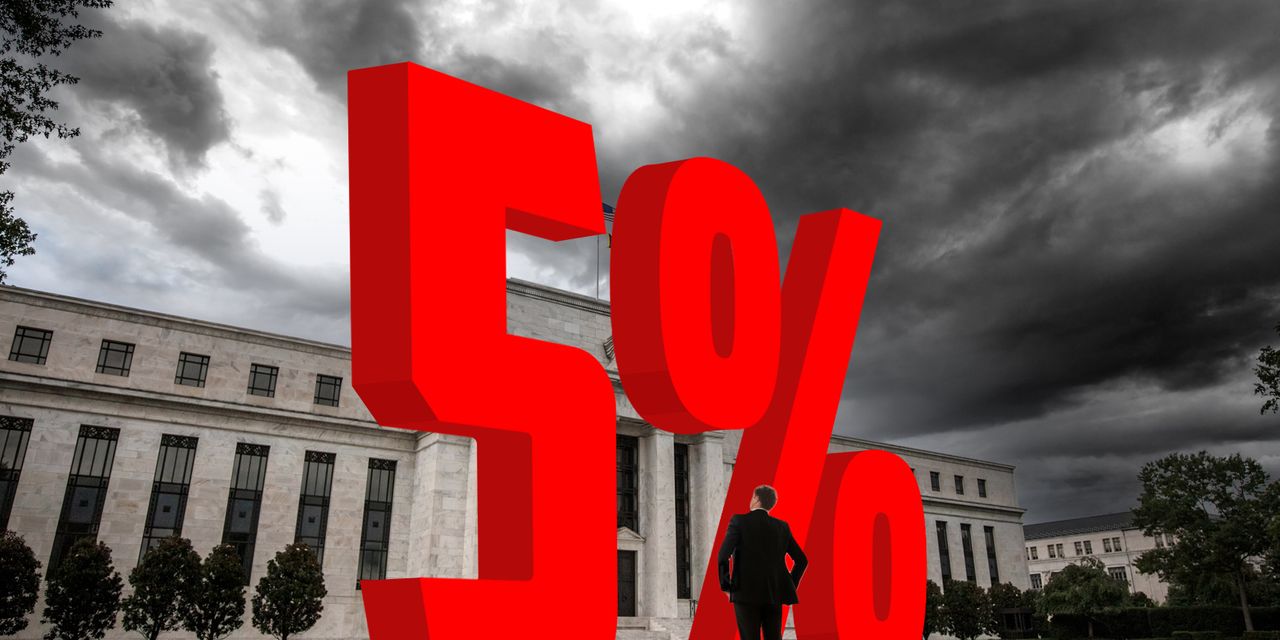With inflation showing no signs of letting up, expectations are building in financial markets for a 5% fed-funds rate by March that’s likely to bring more volatility across equities, bonds and currencies.
Barclays sees the benchmark U.S. interest-rate target getting to 5% to 5.25% by February — from a current level between 3% to 3.25% — on the back of “more aggressive, front-loaded” rate hikes by the Federal Reserve, according to a note released Thursday. Meanwhile, fed funds futures traders see a 31% chance that rates get to that level by next March, up from 6.1% on Wednesday, according to the CME FedWatch Tool.
See: Fed’s benchmark interest rate may peak above 5% after Sept inflation data, some economists think
The game-changer was Thursday’s hotter-than-expected consumer-price index report for September, which reflected worrisome jumps in the core readings that exclude food and energy and produced the seventh straight 8%-plus annual headline reading. Until now, many in financial markets have struggled to adjust to the likelihood of just a roughly 4% fed-funds rate by November, which would be the highest level in more than a decade. Now, traders and economists are pointing to the likelihood of further volatility as expectations grow around a 5% fed-funds rate — a level last seen in 2006 — with investors poised to dump stocks and bonds and to favor the dollar.
A 5% fed-funds rate would be “negative for stocks and earnings and lead to more selloffs in bonds,” said Tom di Galoma, managing director of rates trading at Seaport Global Holdings in Greenwich, Conn. “It would also be absolutely devastating for the economy. The loan market would be completely shut down at that point, and banks would not be approving housing loans or loans to companies.”
“People are just completely taken aback by rates that have moved as much as they did over the last three months. I certainly did not expect a 5% 2-year rate, but that seems to be where we might be heading,” di Galoma said via phone. “We’re going to see not a shallow recession, but something more massive than people are used to. We’re going back to at least the Global Financial Crisis here because every place in the world is slowing” and all these markets are in the process of “breaking down.”
Rex Nutting: Everybody is looking at the CPI through the wrong lens. The best measure shows inflation fell to the Fed’s target in the past three months.
On Thursday, investors reacted to the September CPI report by initially driving down all three major U.S. stock indexes
DJIA,
SPX,
before they bounced back sharply to hold strong gains in afternoon trade. Analysts said stocks were due for a squeeze higher after a six-day selloff that left the S&P 500 on Wednesday at its lowest close since November 2020.
The policy-sensitive 2-year Treasury rate
TMUBMUSD02Y,
soared above 4.4%, while the 10-year yield
TMUBMUSD10Y,
gave up earlier gains and hovered around 3.94%.
Before Thursday’s CPI report, Treasury Secretary Janet Yellen had voiced concerns about the potential for problems related to thin trading conditions in the market for U.S. government debt, according to news reports. She was quoted as saying after a speech on Wednesday that “we are worried about a loss of adequate liquidity in the market.”
A potential lack of liquidity in the $23.7 trillion Treasurys market is just one of many cracks that seem to be forming in financial markets as central bankers raise interest rates at the fastest clip in decades — triggering debate about whether the next financial crisis is inevitable.
Talk of a 5% fed-funds rate has circulated for at least the past month, but always seemed to get buried behind a more general dialogue about what the Fed might do in November.
The reason that the CPI report moved the needle is because “hopes that lower inflation was going to come from a resolution of supply-chain adjustments have faded, and supply-chain improvements that have been passed through to consumers are still not enough,” said Will Compernolle, a New York-based senior economist at FHN Financial. “The era of globalization that puts downward pressure on goods prices may be over.”
He said that FHN’s chief economist is expecting a 6% fed-funds rate rate at some point, which will exacerbate global recessionary headwinds and keep the dollar strong. The first thing that could break in the global economy “is Europe as it goes into a severe downturn,” Compernolle said via phone on Thursday.
For Ben Emons, managing director of global macro strategy at Medley Global Advisors in New York, “it is without a doubt that U.S. inflation is getting out of control.”
Equity markets have yet to price in the likelihood of a 5% fed-funds rate by the first half of 2023, Emons wrote in an email on Thursday. The immediate consequence of the latest inflation update confirming inflation is averaging 8% year-over-year is that it “puts the Fed on track to follow what the central bank of Brazil did,” which is hike rates above inflation.



